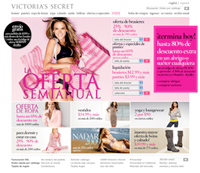
Victoria’s Secret This Past Fall Quietly Launched a Spanish-language mirror site. The lingerie merchant hopes the new site will better serve its Spanish-speaking customers in the U.S. and around the world, says Steven Goldsmith, executive vice president of Victoria’s Secret Direct Internet.
“This will help us reach an audience we already know loves the brand and products, “Goldsmith says. But he admits the site is a work in progress, and says the company plans to make improvements to it this spring.
Some experts in marketing to Hispanics say that Victoria’s Secret might start with the site’s Spanish translation. “It’s more ‘Spanglish’ than it is Spanish,” says Renato Beninatto, chief connector at international business research and consulting firm Common Sense Advisory.
Victoria’s Spanish-language site indicates that the coding was done by Website translation service MotionPoint. And MotionPoint “is like an overlay for the Website — it’s a tool that will work well on translations and content management, but not affect the shop database,” says Beninatto.
So that means the product pages are translated, but the actual products are still in English. This can be confusing. And the site translations, in some places, fall flat, Beninatto says. He had four coworkers look at the site.
The first thing they all noticed was the incorrect translation of “swim” as a tab. It is translated into “nadar,” which is the verb “to swim,” as opposed to the word “playa,” which would indicate something worn to the beach.
The translation of “check order status” is read in Spanish as “social status,” Beninatto says.
On the plus side, Beninatto says, Victoria’s Secret’s Spanish-language site allows viewers to toggle between the English- and Spanish-language sites seamlessly, which is a good thing.
Lee Vann, CEO/founder of Hispanic marketing consultancy Captura Group, agrees. Overall, Vann is forgiving on some of the language issues: “It’s pretty much a straight translation, and the imagery is all the same in both language sites, which should help out with some of the language barriers,” he says.
The Hispanic market is not an easy one to crack, especially when you consider that translations for Spanish-speakers in the U.S. are different for Mexican-Americans living in the Southwest, Cuban-Americans in Florida, and Puerto Ricans in the New York area.
One thing that may also help Victoria’s Secret is its choice of models, Vann says. The brand traditionally has used models from many different ethnic backgrounds, which could also help Victoria’s Secret gain footing both in the U.S. and in international markets.
